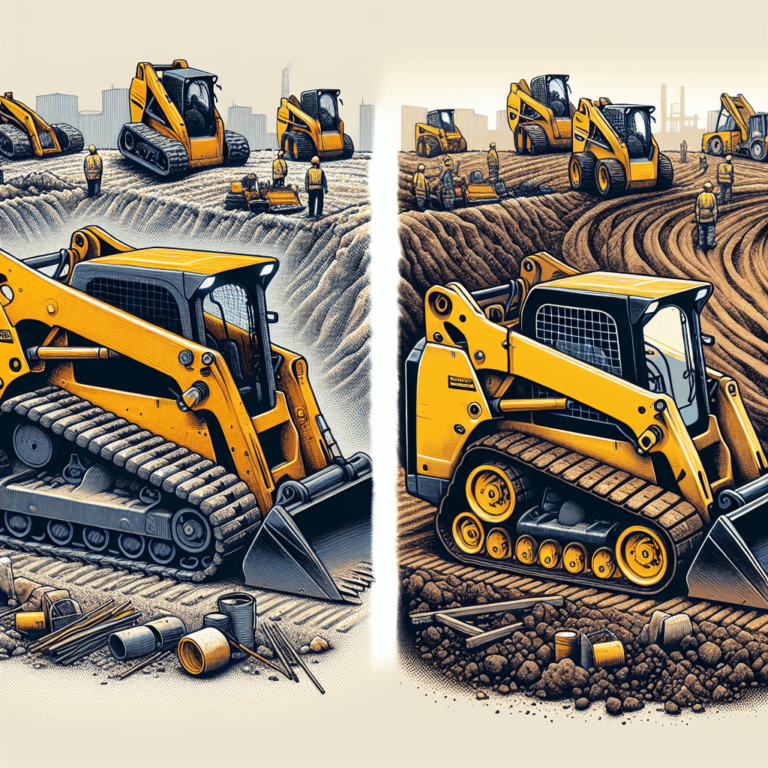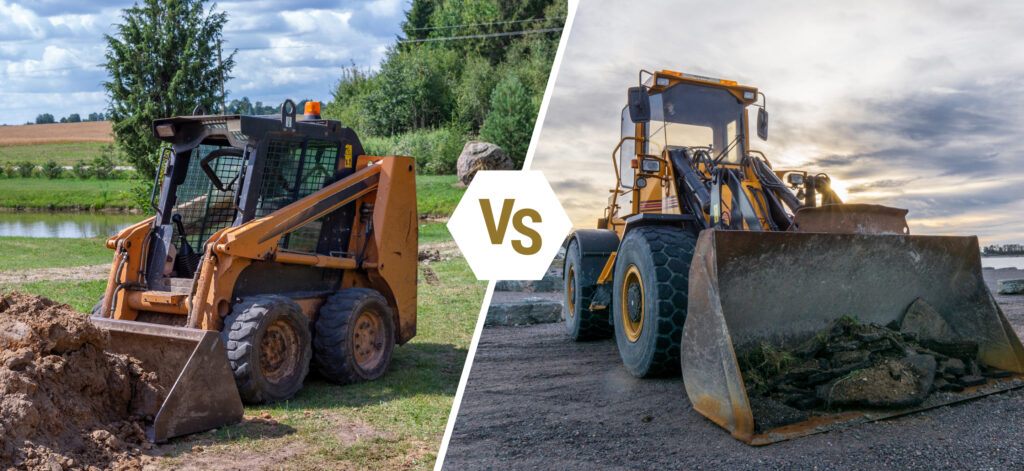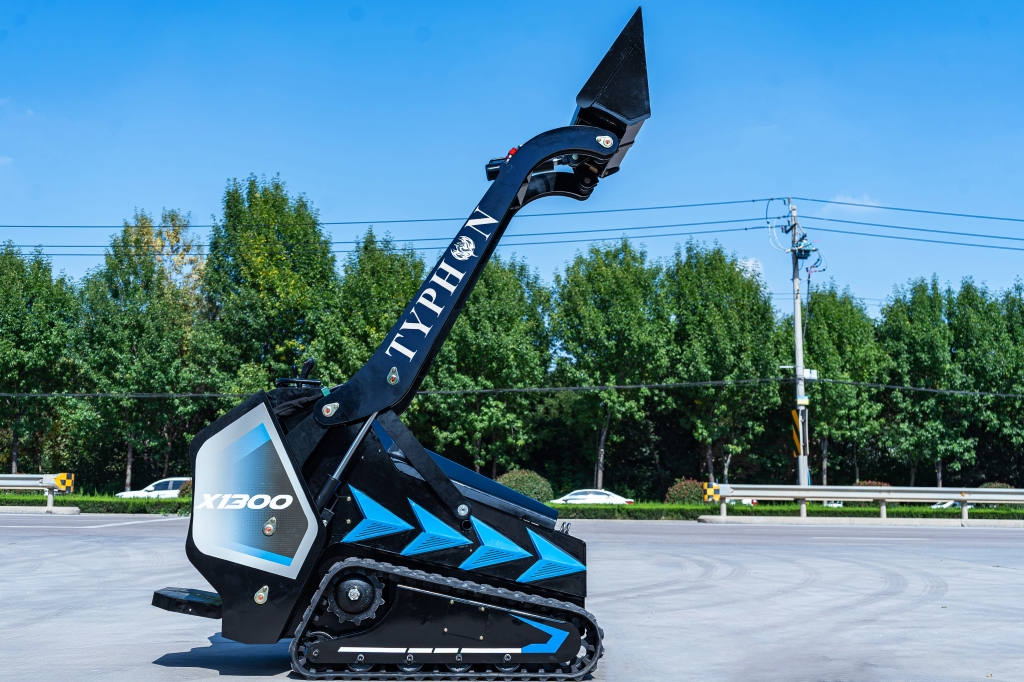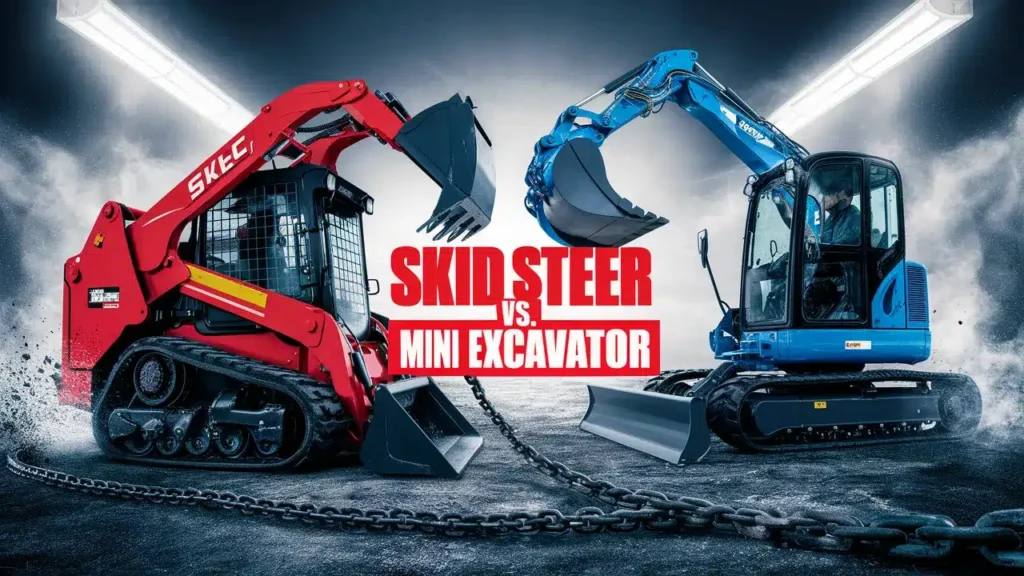Introduction to Heavy Equipment Choices
In the fast-paced realm of construction and landscaping, selecting the right equipment can mean the difference between a seamless project and frustrating delays. Among the numerous options available, Skid Steer vs Track Loaders emerge as versatile, powerful, and indispensable tools. But how do you decide between the two? By grasping the key differences and similarities between these types of heavy equipment, you can enhance your workflow and maximize your investment.
Both Skid Steer vs Track Loaders have their places in construction, but their unique features and performances cater to different project needs. Whether you’re a seasoned professional or new to the field, making an informed decision about whether to use a skid steer or track loader can greatly enhance your productivity and job satisfaction. Read on as we explore the distinct advantages and disadvantages of each, providing insights directly from industry professionals to guide you in selecting the best fit for your tasks.
From maneuverability to ground disturbance, cost to application specifics, we’ll break down everything you need to know to make the best choice. By the end of this guide, you’ll have a clear understanding of which piece of equipment aligns with your operational needs and how to optimize your investment with Typhon Machinery’s extensive offerings.
Skid Steers Advantages and Disadvantages
Maneuverability and Versatility
One of the standout features of skid steers is their exceptional maneuverability. Designed to pivot effortlessly within its own footprint, a skid steer can easily handle tight spaces and complex job sites, making it an ideal choice for urban environments and confined work areas.
Additionally, the versatility of skid steers is unmatched. With a wide range of attachments available, from augers to trenchers, skid steers are like the Swiss Army knife of the construction world. Their ability to quickly swap tools allows operators to perform multiple tasks without switching machinery, saving time and increasing efficiency.
However, this versatility comes with a learning curve. Operating a skid steer requires a keen understanding of its controls and attachments. For operators willing to invest the time to master this machine, the pay-off is a highly adaptable piece of equipment that can tackle a diverse array of jobs.
Ground Disturbance and Traction Issues
Despite their maneuverability, skid steers have notable disadvantages, particularly concerning ground disturbance and traction. Their wheels can cause significant soil disruption, especially on soft or unstable surfaces. This makes them less ideal for landscaping projects where maintaining existing ground conditions is crucial.
The rubber tires of skid steers also present traction challenges on slippery or uneven terrain, potentially limiting their use in certain environments. Operators need to be mindful of surface conditions, as poor traction can lead to decreased efficiency and increased wear on the machine.
While these issues can be mitigated with proper technique and planning, they are important considerations when selecting equipment for projects that require minimal ground impact.
Comparison with Track Loaders in Terms of Performance
When it comes to performance, skid steers and track loaders both bring strengths and weaknesses to the table. Skid steers excel in speed and ease of transport due to their lighter weight and compact size, making them a go-to choice for smaller jobs requiring quick turnaround times.
Conversely, track loaders offer superior stability and flotation on challenging terrains, making them better suited for projects that involve rough or uneven ground. Understanding these performance nuances is key to choosing the right equipment for your specific project needs.
By evaluating the trade-offs between maneuverability and traction, operators can align their equipment choice with project goals, ensuring maximum efficiency and effectiveness on the job site.
Track Loaders Advantages and Disadvantages
Superior Traction and Flotation
Track loaders are celebrated for their superior traction and flotation capabilities. Thanks to their continuous tracks, track loaders distribute weight more evenly across the surface, reducing ground pressure and increasing stability on loose or muddy terrain.
This feature is particularly beneficial for landscaping and construction projects that require minimal ground disturbance while navigating challenging environments. The better traction also allows track loaders to push larger loads and operate more efficiently under load.
However, this increased traction comes at a cost — both financially and in terms of maneuverability. Understanding the full scope of these trade-offs is essential for making an informed decision.
Limited Maneuverability
While track loaders shine in challenging terrains, their maneuverability is somewhat limited compared to skid steers. Their larger size and heavier weight make them less nimble, which can be a disadvantage in tight or restricted areas.
Operators must plan carefully when using track loaders in confined spaces, as their wider turning radius requires more room to maneuver effectively. In environments where space is a premium, the agility of a skid steer may provide a better fit.
Despite this limitation, the enhanced stability and load-bearing capabilities of track loaders often outweigh their maneuverability drawbacks, especially in projects demanding robust performance over raw speed.
Analysis of How These Factors Affect Productivity
The choice between skid steers and track loaders ultimately boils down to how these factors impact overall productivity. Track loaders offer consistent performance in challenging conditions, allowing for steady progress without frequent interruptions.
For projects where terrain variability is a concern, track loaders provide a reliable solution by maintaining traction and stability. This can lead to fewer delays and a smoother operation, enhancing productivity.
On the flip side, the skid steer’s speed and versatility make it ideal for projects with frequent changes in task requirements, where quick adaptability is needed. By understanding these productivity dynamics, construction professionals can select machinery that best meets the demands of their work.
Pros and Cons of Skid Steers and Track Loaders
Skid Steers
Pros:
- Maneuverability: Excellent in tight spaces, able to pivot and navigate complex job sites.
- Versatility: Wide range of attachments available, enabling multitasking without the need to switch machines.
- Speed: Generally faster and easier to transport than track loaders, making them ideal for smaller projects.
Cons:
- Ground Disturbance: Can cause significant soil disruption, which may be problematic for landscaping or projects requiring minimal impact.
- Traction Limitations: Performance can degrade on slippery or uneven surfaces, potentially affecting efficiency.
Track Loaders
Pros:
- Superior Traction: Continuous tracks improve stability and flotation on loose or muddy terrains, making them a reliable choice for challenging environments.
- Load-Bearing Capacity: Better equipped to handle larger loads, enhancing productivity in demanding projects.
Cons:
- Limited Maneuverability: Heavier and larger, making them less agile in confined spaces compared to skid steers.
- Higher Cost: Typically more expensive to purchase and maintain than skid steers, requiring careful budget consideration.
Cost Comparison
Initial Investment
When comparing skid steers and track loaders, initial investment is a significant consideration. Generally, track loaders demand a higher upfront cost due to their more complex track systems and enhanced capabilities.
While skid steers present a more budget-friendly option for those entering the market, it’s important to weigh this against the potential benefits and efficiencies offered by track loaders. The right choice will largely depend on the specific needs and resources of your business.
Investing in the right equipment involves looking beyond the price tag to consider long-term value and return on investment.
Operating and Maintenance Costs
Beyond the initial purchase, operating and maintenance costs play a crucial role in the overall cost comparison. Track loaders typically incur higher maintenance costs due to their track systems, which require regular inspection and potential replacement.
Skid steers, on the other hand, boast simpler maintenance, with tire repair and replacement being the main concern. This can result in lower ongoing expenses, making them appealing to companies with tighter budgets.
Factoring in these ongoing costs will ensure a comprehensive understanding of the financial commitment involved with each equipment type, aiding informed decision-making.
Financial Considerations in Choosing Equipment
Selecting the right heavy machinery involves careful financial consideration. While upfront costs are important, understanding the full financial implications, including long-term operating expenses, will provide a clearer picture of the total investment.
Companies should assess their specific project needs, budget constraints, and projected workload to determine the best fit. By aligning financial resources with operational goals, businesses can optimize their investment for sustainable growth and success.
Life Span and Durability
When evaluating heavy machinery such as skid steers and track loaders, understanding their life span and durability is critical for long-term planning and investment. Generally, track loaders are engineered for robust performance in harsh environments, often resulting in a longer operational life compared to skid steers. The sturdy construction and reinforced components of track loaders enable them to withstand rigorous use and extreme conditions, contributing to their longevity.
Conversely, skid steers, while versatile and agile, may exhibit a shorter life span due to their susceptibility to ground disturbance and wear from varied terrain conditions. However, regular maintenance and proper operation can significantly extend the durability of either equipment type. It is essential for operators to adhere to manufacturer maintenance schedules and best practices to maximize the life span of their machinery, ultimately protecting their investment and ensuring reliable performance throughout its service life.
Application Specifics
Best Uses for Skid Steers and Track Loaders
When it comes to application specifics, both skid steers and track loaders perform best under different conditions. Skid steers excel in urban environments and small-to-medium-sized projects, where their maneuverability shines.
In contrast, track loaders claim the upper hand in larger, more open areas with challenging terrains, including landscaping and forestry applications. Understanding these strengths will guide professionals in choosing the right equipment for their specific tasks.
Tailoring equipment to project conditions not only improves efficiency but also enhances the overall quality of work.
Case Studies and Testimonials from Industry Professionals
To better understand the practical applications of skid steers and track loaders, consider insights from industry professionals. For instance, a construction company in urban settings may find skid steers indispensable for their ability to work in tight spaces, quickly switching between attachments as needed.
Conversely, a landscaping firm specializing in terrain modification might favor track loaders for their stability and traction on varied landscapes. These real-world examples demonstrate how equipment choice directly impacts project outcomes, offering valuable lessons for other professionals.
Testimonials from satisfied users further highlight the equipment’s capabilities, showcasing its impact on productivity and project success.
Practical Insights for Choosing the Right Tool
Choosing the right tool involves more than just understanding specifications — it’s about aligning equipment with your specific operational needs. Factors such as terrain, project size, task diversity, and budget all play integral roles in the decision-making process.
By considering these elements and leveraging insights from industry professionals, operators can tailor their equipment selection to match their unique requirements. This approach ensures efficiency, cost-effectiveness, and satisfaction on every project.
How to Decide Between Skid Steers and Track Loaders for Earthmoving
Deciding between skid steers and track loaders for earthmoving tasks hinges on several key factors that affect project efficiency and outcomes. First, assess the nature of the terrain: if the project involves navigating through tight spaces, uneven ground, or urban environments, skid steers are typically more suited due to their agility and compact size. On the other hand, for larger projects on soft or rough terrains, track loaders provide superior stability and traction, making them the better choice.
Next, consider the types of attachments needed for the job. Skid steers are known for their versatility with a broad range of compatible attachments, allowing for rapid changes in functionality. However, if the project demands heavy lifting or significant earthmoving in adverse conditions, track loaders’ robust build and powerful operation come into play. Finally, evaluate your budget, not just in terms of initial investment but also ongoing operational costs. Weighing these aspects together will facilitate a well-informed decision, ensuring that the chosen equipment aligns with both immediate project needs and long-term operational goals.
Making an Informed Choice for Your Earthmoving Tasks
Evaluating several factors can help you decide whether a skid steer or compact track loader (CTL) is the better option for your needs:
- Lifting Power and Traction: Determine if your job requires a CTL for more lifting power and traction or a skid steer for speed and maneuverability. If the task demands heavy lifting in challenging conditions, a CTL may be your best choice. Conversely, if agility and quick task changes are paramount, a skid steer could be more advantageous.
- Ground Conditions: Consider the surface you’ll be working on: is the site relatively smooth and flat, which works well for a skid steer, or is it soft and wet, best suited for a CTL? The condition of the ground can significantly influence the performance of the chosen equipment.
- Cost: Your budget may be the deciding factor when selecting a machine. A skid steer will likely require a lower upfront expenditure and be less costly to operate and maintain, making it an attractive option for smaller projects or those with tighter budgets.
- Attachments: While both machines can accommodate a variety of attachments, it’s crucial to ensure that the chosen skid steer or CTL can utilize the specific tools you require to complete your projects effectively. Assessing the compatibility of attachments will help maximize the functionality of your equipment.
Conclusion and Decision-Making Guide
Summarizing Key Points
Navigating the decision between skid steers and track loaders involves understanding each equipment type’s unique strengths and limitations. Skid steers offer unmatched maneuverability and versatility, ideal for dynamic projects in confined spaces. Conversely, track loaders excel in challenging terrains with their superior traction and flotation capabilities.
Armed with an understanding of cost implications and application specifics, construction professionals can make informed choices that align with their business goals and operational needs.
Making an Informed Decision
Ultimately, the right choice depends on a thorough assessment of your specific project requirements and resources. Consider factors such as terrain, budget, task diversity, and desired outcomes when selecting equipment. By doing so, you’re poised to select the best tool for your particular challenges and opportunities.
For professionals seeking expert guidance and equipment demonstrations, Typhon Machinery offers a wealth of resources to assist you in making the most informed decision possible.
Explore Further with Typhon Machinery
Ready to make your choice? Reach out to Typhon Machinery for personalized consultations and equipment demonstrations tailored to your needs. Our team of experts is here to help guide you through the selection process, ensuring you find the perfect fit for your construction and landscaping projects.
Explore Typhon Machinery’s extensive catalog of skid steers and track loaders, each designed to meet the highest standards of performance and reliability. Discover the difference the right equipment can make in your operations today.
Browse Quality Equipment from Typhon Machinery
At Typhon Machinery, we understand that the right tools can significantly influence the success of your construction and landscaping projects. Our extensive range of high-quality skid steers and track loaders is tailored to meet the diverse needs of professionals in the industry. Each machine is designed with durability, efficiency, and performance in mind, ensuring that you can tackle any job with confidence.
Explore our inventory to find models equipped with advanced features, versatile attachments, and robust engines that provide the power you need for even the most demanding tasks. Whether you’re looking for compact solutions for tight spaces or heavy-duty options for challenging terrains, Typhon Machinery has you covered. Visit our website today to browse our selection and discover the perfect equipment to enhance your operational capabilities.

